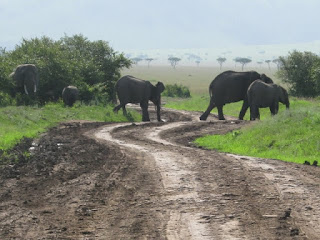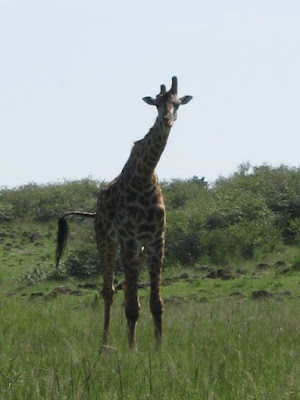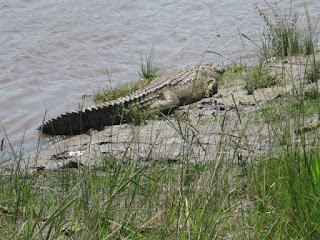I left our house on Tuesday afternoon, January 12th, at about 2:30. I was scheduled to take a 5:20 p.m. flight to London's Heathrow Airport. After landing at 9:05 a.m. GMT Wednesday (2:05 a.m. Mountain Time), I was scheduled to fly on to Nairobi, Kenya, leaving at 10:05 a.m. GMT and arriving in Nairobi at 9:35 p.m. Nairobi time (6:35 p.m. GMT, 11:35 a.m., Mountain Time).
When I checked in at Denver, the ticket agent said the flight was delayed 20 minutes and faced some strong headwinds. She doubted I'd be able to make the connection. So to ensure I would have a replacement flight, she pre-booked me on a Virgin Atlantic flight out of London that would leave Wednesday evening at about 9:30 and arrive in Nairobi Thursday morning.
As it turned out, our flight took off on time and made good time over to London. Except, about an hour from London, the captain came on the intercom: "London is experiencing snow and so we have been placed in a holding pattern that, we expect, may last up to an hour and a half. Happily, we were warned of such a possibility, so we have enough
fuel . . ."
Over the course of the next couple of hours, we received updates. We were finally permitted to come in at about 10:15 in the morning. But the inch of snow was so debilitating for Heathrow operations that there were no jetways available for us to park. "While jets coming in have been slowed, almost no jets have been permitted to take off," our captain informed us.
That gave me hope I might actually make my connection.
But an hour later, when we finally got off the plane, I discovered my flight had left long before.
So I was in for an extended stay at Heathrow.
After wading through a number of customer service waiting lines, I finally made my way to one of the Virgin Atlantic business lounges at about 2 in the afternoon and made myself at home for a few hours.
One of my first obligations: to send an email to notify my host in Nairobi that I would not be on my flight that evening, but should be seeing him Thursday morning.
The Virgin Atlantic business lounge is the most pleasant airline lounge I have ever been in. Not only do they offer the standard amenities of any high-end lounge (free snacks, drinks, newspapers and magazines, showers, etc.), but they offer an amazing sit-down restaurant food service at no charge.
I enjoyed my stay.
That evening, we finally took off at about 10:30 and arrived in Nairobi Thursday morning--about 10 o'clock local time, as I recall.
Having only my carry-on luggage, I was one of the first to get to immigration.
Oh! I needed a visa. (I hadn't known.) Charge: US$25.
Okay. I hadn't brought along much in the way of US currency, but I could cover that.
Except the officer scowled: "Where am I supposed to put your visa? I have no space in your passport for a visa!"
"Well, can't you use this page?" I asked, pointing to the very last page in the book.
"I am not permitted to put a visa on that page," he said. And he pointed to the barcodes at the bottom.
"But there is room," I countered.
"I should really send you back," he said. "I am not supposed to let you in."
But then he relented. And I realized I have to get additional pages for my passport before I venture forth on another international trip.
When I emerged from the terminal, I looked for my ride.
I saw no one who looked like he (or she) was looking for me.
I walked up and down the line.
No one.
I need to go to the bathroom. Hopefully they will show up while I'm in there, and then we can leave.
When I emerged, still there was no one.
I walked up and down the line once more.
No one.
"Taxi!? Taxi?!" called several entrepreneurial spirits a little apart from the crowd of greeters.
"No thanks," I replied.
But I was perplexed.
What should I do?
I had no phone number, no way to know what I should do.
"May I help you?" a nicely dressed man asked.
"I need to find the Waine Hotel," I said.
He called information. No Waine Hotel. He brought me to a friend in a booth. We looked it up in the Yellow Pages under Hotels. No Waine Hotel.
"I'm sure that's where I'm supposed to go," I
said. . . .
A few minutes later, my new friend said, "Ah! It's not the 'Waine Hotel'; it is 'The House of Waine.'"
"Oh, yes!" I said.
"I can take you there," he offered. And a few minutes later I was on my way to the
House of Waine.
I had no idea what I was in for.
Half an hour later, I was dropped off at the most astonishing hotel I could imagine seeing, much less staying at. And I walked in on a meeting of about thirteen fellow travelers who had arrived the night before and were now being briefed on missions work among the Deaf.
An hour later, we were told to gather a few things together for an overnight trip to the
Kichwa Tembo tent camp on the border of the
Masai Mara Game Reserve in southwest Kenya.
First we took a whirlwind tour of the current DOOR facility in downtown Nairobi, ate lunch, and then boarded a small twin-engine piston propeller plane for what turned out to be a 45-minute airplane ride that ended with what may have been the smoothest landing I have ever experienced
. . . on a dirt runway in "the middle of nowhere."
Several 10-passenger Land Rovers were waiting, and before you knew it, we were heading off into the bush to see what we could see.
I figure I'll let some photos help tell the story. [Apologies to photographers: I was using a Canon PowerShot A480 and was pushing its limits at every turn. Sadly, the shutter lag time combined with poor quality batteries militated against shooting dozens of photos when it would have been helpful. And, further, I often pushed my lens into digital telephoto territory
. . . which almost always destroys detail. Still, I want to illustrate what I saw!]
So. Let's
see. . . .
First thing that caught our eye as we were driving away from the landing strip: a large herd of elephants.
And zebras. . . .
A rhino way too far in the distance . . .
Some of the most beautiful birds . . .
And ugly . . .
(By the way: the ostrich on the right is male: he has black plumage; the females' plumage is merely a dark gray.)
Here he is running away . . .
Ugly ducks?!?
Ahhh!
Warthogs . . .
Lots of warthogs! (Though I didn't get very many decent photos. The warthogs always seemed to scamper off at high speed whenever we came within 50 yards
. . . their tails always high in the air.)
. . . Well. Except for this one . . . and one or two of its brothers or
sisters . . .
This one was rooting around on the grounds of our campsite on Friday afternoon. Notice he is kneeling on his front legs so he can get his mouth down close enough to the grass to eat!
. . . Hyenas. This one crossed right in front of our vehicle as the elephant herd we saw right after getting of the plane passed
by . . .
My camera wasn't fast enough to capture more than this one shot. . . . Until we found a mother with her pups
. . . but then I couldn't get that mother's head, either.
Oh, well! The pups sure are cute!
How about baby Thompson's gazelles hiding in the grass . . .
And an adult Thompson's gazelle (one among thousands we saw, though this was the only photo I took that came out well). . .
Ah! One of my favorites: the elegant, multi-colored
topi:
. . . Lots of giraffes!
(See them walking across the field?)
Ah! Here's a better shot! --Notice how rich their colors are! Way deeper and darker than I recall seeing on any of the giraffes I've seen here in the
States. . . .
See the bird riding on the base of his neck? . . . Here's a better shot:
And . . . take a look at this guy: one horn shorter than the other!
Cape buffaloes . . .
. . . When he began to get up . . .
. . . our driver said we had best be going. --The Cape buffalo is, we were told, the fiercest of all the animals in that part of Africa.
. . . Oh. How about lions?
Early Friday morning, I was afraid this was going to be about all we would get to see of them: four cubs hiding in the grass on top of a mound:
Can you see their heads just barely popping above the top of the grass? (The fourth one is about a fifth of the way in from the left edge of the photo, slightly in front of his "brother" (or is it sister?) at the top of the mound.)
. . . But later in the morning we came across a couple of lions just lying beside the road. . . .
Our driver suggested that, considering how inactive they were, they must be on the tail end of their "honeymoon."
After about five minutes, the male woke up and took a gander at the humans looking at them . . .
The female kept sleeping. . . .
We continued to sit quietly for quite some time just watching.
I was astonished to notice how rapidly the female was breathing. (Our driver said they pant at a rate of about 200 breaths per minute. And that sounded about right.) But what was most amazing was how hard she seemed to work for each breath. Her entire body, including her head, bobbled about on each breath!
Eventually she roused herself . . .
And a giraffe decided to walk on by . . .
. . . and the female decided to go for a walk herself . . .
"Hey! Don't leave without me!" said the male . . .
"Just thirsty, Honey. . . ."
"Good idea!"
Let's see. What else?
Hippopotami . . .
. . . and crocodiles!
Dung beetles . . . rolling their ball of . . . dung . . .
Notice that the one on the right has his hind legs up in the air on top of the ball; the beetle on the left has his front legs up on top of the ball.
. . . They were rolling the ball from right to left across the field of view in this
photo. . . .
Oops! The guy on the right shoved just a bit too strenuously
. . . and toppled his mate!
Probably the nicest photo I got in my entire trip: an impala! --What gorgeous horns!
. . . Well, that's about all of my decent animal photos.
While we're out in the "bush," however, I'd like to point out a few items I noticed about the environment in Masai Mara.
1) Our camp in Masai Mar was at 5,360 feet elevation--very close to our elevation here in the Denver metro area . . . which means the air was pleasantly warm, neither hot nor cold (though we were only a couple of degrees south of the equator).
2) We were told that if we had come just a few weeks earlier, the landscape would have been a dry and dusty brown. They had suffered a lengthy drought that was broken in just the preceding three weeks or so by massive rain. --You can see what a great difference that rain made!
3) We think of Colorada as "Big Sky Country" (though if I remember accurately, Montana claims that verbiage as its state motto). Sarita and I have never lived in a place that has such "big sky"--unimpeded views that extend "forever."
. . . Well, if you noticed, the sky in Masai Mara was huge. It beats Colorado for enormity. The landscape seemed to extend at least twice as far as anything I've seen here in Colorado.
And then, finally,
4) I was taken by the trees. Such a strange appearance: flat across the top and "naked" until just the last couple of feet of canopy:
The trees' shape is so regular, from a distance, it can almost create the appearance of a river of light beneath the canopy and above the shrubbery beneath:
I discussed this phenomenon with our guide. Obviously, the reason the trees are denuded up to a certain height is because of the giraffes.
"But considering how thoroughly the giraffes strip the leaves below that particular height,"I asked, "how can young trees survive so as to get to the height where they can grow a foot or two of canopy?"
"That's very interesting," she replied. "Actually, if the giraffes eat enough of their leaves to begin to threaten the trees' survival, the trees change their chemistry and produce tannins
. . . which are very bitter chemicals and make the leaves completely unattractive to the giraffes."
*******
Okay. I'm stopping here.
Hope you found the photo tour interesting!
[NOTE: If you are reading this article on Facebook and can't use links or don't see photos, please realize it originally appeared and is still available on my personal blog.]
![Reblog this post [with Zemanta]](http://img.zemanta.com/reblog_e.png?x-id=cae76a26-0999-49a8-a02a-0241c115882c)

![Reblog this post [with Zemanta]](http://img.zemanta.com/reblog_e.png?x-id=cae4b03f-2f76-4c62-94a6-8b6f6c34a569)

![Reblog this post [with Zemanta]](http://img.zemanta.com/reblog_e.png?x-id=f7926ad2-a273-486b-9675-a7cd6fffd286)
![Reblog this post [with Zemanta]](http://img.zemanta.com/reblog_e.png?x-id=37d8b3a3-608f-49f1-a6ae-5f2b4fef51de)




























































